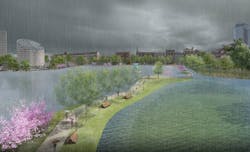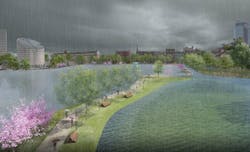Stormwater: Turning Storm Water Threats into Blue-Green Spaces
Over the next 30 years Copenhagen will be implementing a new and ambitious cloudburst master plan protecting the city against 100-year flood events. Recently, the plan and its 300 projects have been finally approved by the city council and the initiative is now inspiring cities worldwide.
By Christian Nyerup Nielsen
In 2010 and 2011 Denmark capital city Copenhagen was hit by three devastating cloudbursts over a 12 month period. Major roads and other infrastructure were flooded and the total damage from the worst and most destructive of the three events cost the city more than US$850 million.
As a consequence, the municipality of Copenhagen initiated an economic analysis that indicated that the cost of doing nothing to mitigate flooding would triple in a 100 years due to climate change affecting the weather patterns.
As as result, the municipality decided to implement a cloudburst master plan for the protection of the city against future cloudbursts.
The plan, entitled ‘Copenhagen Climate Adaptation Plan’, released in 2011, entails around 300 projects and it was finally approved by the City Council in Copenhagen in November 2015. The full implementation of the plan is expected to cost around 1.5 billion USD and presumably take around 20 years.
Ramboll Environ has contributed to the hydraulic basis of the plan by building a calibrated hydraulic model and carrying out initial flood calculations for the whole city. Another Danish based consultancy, COWI, assisted Copenhagen with the main part of the plan.
Blue-Green Infrastructure
The main principle of the plan is to keep water on the surface and control it there rather than just install large, expensive pipes underground.
Instead of the pipes, so called ‘cloudburst streets’ will collect and transport the water away from the vulnerable, low-lying areas. Moreover, multi-functional spaces such as parks and playgrounds will be designed to collect and retain water during heavy rainfall while in the dry periods serve as recreational ‘blue-green’ spaces enhancing the liveability of the city.
This ‘blue-green infrastructure’ approach intends to create synergy for the city as a whole through visionary solutions: water on the terrain will serve as a resource in the city space, and central retention will be created in public spaces.
An Urban Beach Park
A socioeconomic analysis has shown that the benefit from this blue-green approach by far exceeds the costs of construction and maintenance. Even though the budget is €1.5 billion over a 30-year investment period, the benefits from prevented flooding and reduced damages exceeds the investments.
Copenhagen is divided into seven catchment areas that form their own hydrological unit, and prioritised project packages are made for each catchment area. As a part of the overall plan, eight concretisation plans have thus been developed.
One of the more radical suggestions in one of the cloudburst concretisation plans is to transform one of Copenhagen’s three inner-city lakes, Sankt Jorgen’s Lake, into a beach park by lowering the water level in the lake. This creates a vast area for the collection of rainwater while improving the area’s recreational value.
Another project that has already started is the Sankt Annae Square project in the central part of Copenhagen. This square is currently being renovated as part of a local urban planning project. The renovated square and the streets around it have been designed to carry rainwater connected to extreme rainfalls away from the old buildings and to the harbor.
The water from cloudbursts will be handled both visually on the surface and in pipes underground, and the project works as a demonstration project for cloudburst protection on a national and international level.
Inspiring Other Cities
When fully implemented 30 years from now, the cloudburst concretisation plans will protect Copenhagen from severe storms and will take climate change into account as well. The concretisation plans aim at decoupling 30-40% of the stormwater from sewer system in order to level out the effects of climate change predicted to cause 40% more extreme rainfall over a 100 years period. In order to invest efficiently in reducing carbon emissions and increasing resilience in the fast growing urban areas in the region, we have been engaged to commission a comprehensive study.
The study should give an overview of relevant options within urban infrastructure development along with identification of associated costs and benefits in cities with current populations of 750,000 or more. Again, learnings from the Copenhagen case are a huge asset for us - and an important source of inspiration for the Asian Development Bank. Despite the fact that handling of rainwater on the surface might not be a groundbreaking method, Copenhagen’s blue-green approach and the decision to think holistic and include socio-economic perspectives seem to be a winning strategy creating a valuable source of experience and learnings that other city leaders can use in the years to come.
Christian Nyerup Nielsen is the service line leader for climate adaptation and flood-risk management, Ramboll Environ.
More Water & WasteWater International Archives Issue Articles

